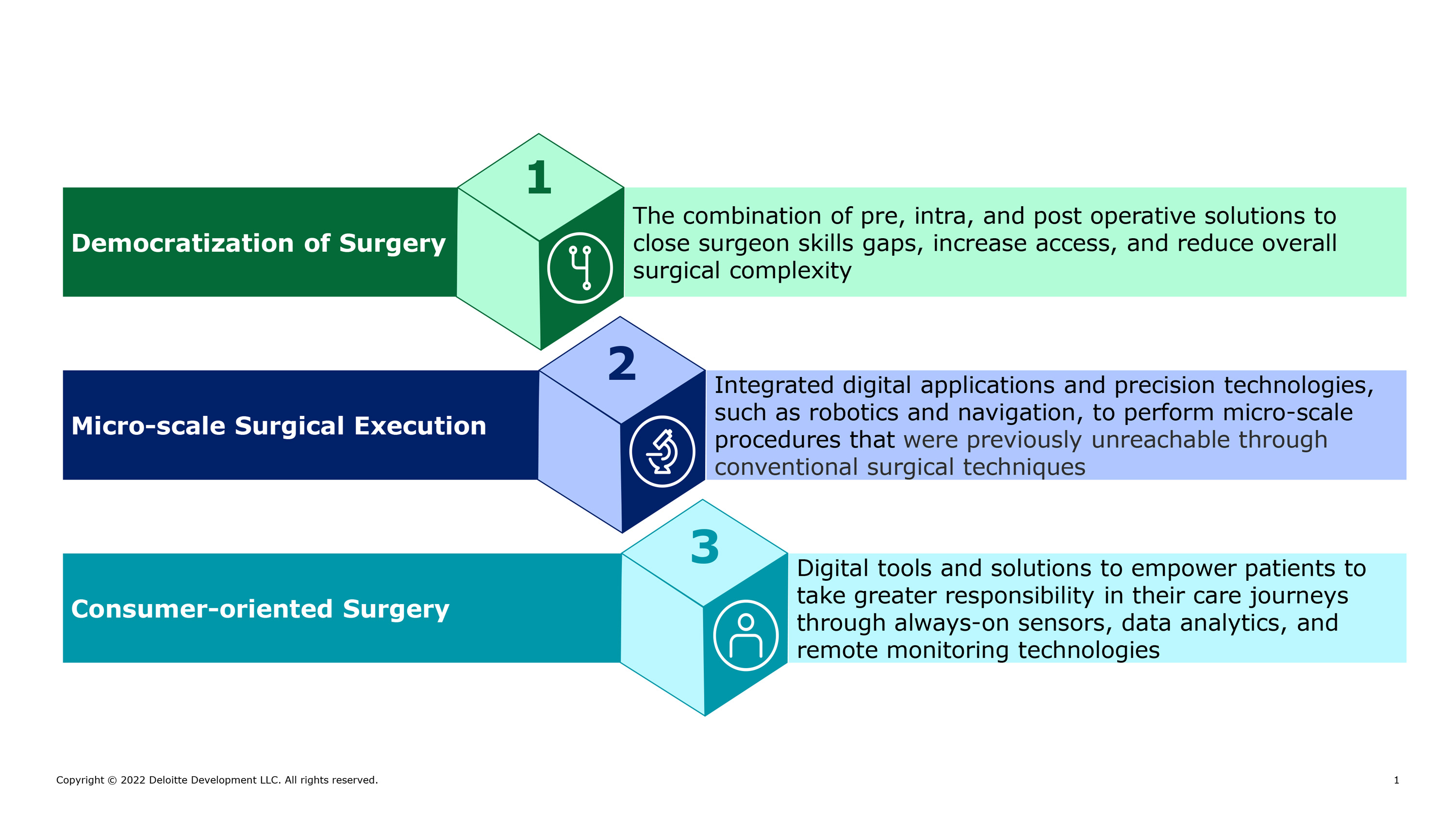ARTICLE SUMMARY:
Every year 60+ million surgical procedures are performed in the United States—more than 100 every minute. Little wonder that digital surgery’s potential is generating excitement and investment among medical technology companies both large and small, as well as other healthcare ecosystem stakeholders. By Glenn Snyder and Matt Yanchek, Deloitte Consulting LLP.

Deloitte Life Sciences
Comprehensive consulting, financial advisory, risk management, audit, tax and related capabilities, along with software products and platforms, deliver value at every step - from insight to strategy to action.
Digital surgery is a hybrid way of treating conditions requiring surgical intervention that brings together human capabilities, digital technologies, and data across the patient care continuum—from diagnosis/pre-surgery to the surgical theater to post-surgical monitoring and intervention. Surgical robots are the most visible example of the shift toward digital: they provide surgeons with an enhanced visual field, superior dexterity, and increased precision. However, robots are only one small part of a burgeoning digital ecosystem.[1]Hospitals and ambulatory surgery centers are investing in cloud computing, 5G connectivity, artificial intelligence (AI),artificial/virtual/mixed reality (AR/VR/MR), and remote monitoring devices to help physicians, caregivers, and patients improve the end-to-end surgical experience. For example, AR,VR, and MR allow surgeons to view medical images and vital signs pre-operatively to improve surgical execution. During the procedure, AR and MR improve the accuracy of surgical instrument placement by over 35% compared to traditional methods.[2]
While still in its infancy, digital surgery offers medtech companies transformative potential to improve clinical outcomes, efficiency, and cost-effectiveness of care episodes requiring a surgical intervention. Many medtechs will likely need to shift their strategies to become hardware- and software-driven companies which assemble individual pieces of a digital surgery ecosystem into various configurations to support the end-to-end patient surgical journey. Doing so will help lay a path to what we see as three possible future vectors for digital surgery. (Click image to enlarge.) 1.Democratization of surgery. Demand for surgical procedures continues to soar,with five billion people currently lacking access to safe and timely surgery.[3]The increased uptake of digital surgery can help improve access to care across geographies and populations. The new field of digital telesurgery, for example, eliminates geographic barriers by allowing appropriately licensed surgeons to operate on distantly located patients. Digital surgery may also help close the surgical skills gap and potentially reduce the need for specialists to perform many complex procedures.Combining pre-operative, patient-specific data with intra-operative robotics and surgical navigation could allow lesser-skilled surgeons or clinicians to perform what has traditionally been more complex surgeries, making it more convenient and affordable for a broader patient population.
1.Democratization of surgery. Demand for surgical procedures continues to soar,with five billion people currently lacking access to safe and timely surgery.[3]The increased uptake of digital surgery can help improve access to care across geographies and populations. The new field of digital telesurgery, for example, eliminates geographic barriers by allowing appropriately licensed surgeons to operate on distantly located patients. Digital surgery may also help close the surgical skills gap and potentially reduce the need for specialists to perform many complex procedures.Combining pre-operative, patient-specific data with intra-operative robotics and surgical navigation could allow lesser-skilled surgeons or clinicians to perform what has traditionally been more complex surgeries, making it more convenient and affordable for a broader patient population.
2. Microscale surgical execution.The combination of integrated digital applications and more precise medical technologies may enable highly skilled surgeons to perform micro-scale procedures that were previously not possible because of the invasive nature of conventional surgery.[4] Today’s robotic-assisted systems deliver high-definition, three-dimensional views of the surgical theater and use tiny instruments to extend the capabilities of surgeons’ eyes and hands.[5]Large medtech companies including Intuitive Surgical, Medtronic, Johnson & Johnson, Stryker, Zimmer Biomet, and Smith & Nephew, as well as smaller players such as CMR Surgical and Vicarious Surgical, are developing next-generation surgical robots that are smaller, portable, more affordable, and easier to use than earlier models for microscale surgical applications in ambulatory surgical centers and other potential future locations.[6]
3.Consumer-oriented surgery. Today, physicians are responsible for making the vast majority of surgical decisions.In the future, patients and their families are going to assume greater responsibility for their care and will need advanced digital tools that empower them to do so.[7]Already, digital technologies are involving the patient earlier and throughout the entire surgical process. Clinicians are using advanced wireless technologies and mobile apps to enable more reliable, timely patient access to pre- and post-operative services, especially for remote populations;collecting and using patient data across the surgical continuum to make surgery more precise; and usingwearable AI and sensors to remotely monitor and collect clinically relevant patient data.[8] Case in point:Zimmer Biomet collaborated with Canary Medical on a smart-knee device called Persona IQ®,which sits inside the non-weight bearing part of a knee replacement and uses sensors, 3D gyroscopes, and 3D accelerometers to track and measure physiologic metrics of post-operative patient activity such as steps, walking speed, stride length, cadence, and distance walked,[9] empowering consumers to use data and technologies to take control of their care.
Considerations for Medtech Companies
Will we see a new world of surgery which is consumerized to the point where patients can select the implants, physicians, and other “add-ons” to their procedure to optimize their result? Could the surgical suite ultimately extend to the home?How quickly will the healthcare financial system align to these new vectors…and/or who will push the change?
While our envisioned Future of Health still calls for brick-and-mortar hospitals, all but the highest-acuity care and surgical procedures (e.g., organ transplantation) will likely shift away from the traditional hospital operating room to alternative settings.This anticipated procedure site diversity is elevating the need for integrated digital solutions and capabilities that support the entire patient journey. However, given the rapid pace of technological innovation, the capabilities that will be necessary, desirable, and feasible for surgery beyond the operating room are likely to be radically different than what is available today. The value propositions for each of the three vectors are also likely to be different, as are the customers to which medtechs will be providing products and services.
Medtech company leaders should assess their current portfolios and determine if they possess the core elements to support their choice of future digital surgery vectors. They also should decide whether their company will build, buy, or partner (with digital surgery innovators and/or health systems) to close capability gaps and assemble the pieces of an end-to-end digital surgery solution that is easy to adapt and configure to customers’ shifts in treatment paradigms, service line strategies, and general and specialty needs.[10] This may require medtechs that historically have targeted specific therapeutic areas defined by a procedure and physical devices (e.g., implantables) to widen their lens to include the digital solutions that surround and support those devices,[11] deliver value across the surgical care continuum, and create a new safety net to extend the care a patient receives from the hospital or outpatient surgical center to their home.

 Glenn Snyder is Principal MedTech Practice Leader with Deloitte Consulting. Matt Yanchek is Senior Consultant, Deloitte Consulting LLP.
Glenn Snyder is Principal MedTech Practice Leader with Deloitte Consulting. Matt Yanchek is Senior Consultant, Deloitte Consulting LLP.
Notes
[1] https://www.zs.com/insights/its-not-about-the-robot-fully-realizing-the-benefits-of-digital-surgery,October 15, 2020.
[2] https://link.springer.com/article/10.1007/s00464-021-08363-8.
[4] Global Surgery 2030:Evidence and Solutions for Achieving Health, Welfare, and Economic Development, The Lancet Commission on Global Surgery,346076_713dd3f8bb594739810d84c1928ef61a.pdf (lancetglobalsurgery.org). Accessed April 20, 2022.
[6] U.S. surgical robots market, U.S. Surgical Robots Market is Set to Reach USD 5,630.7 Million by 2027 (vynzresearch.com), June 2021.
[9] https://www2.deloitte.com/us/en/blog/health-care-blog/2021/smart-knee-brings-future-of-health-one-step-closer-a-conversation-with-canary-medical.html.
[10] The Future of (Digital) Surgery (mddionline.com), Medical Device and Diagnostic Industry, August 1, 2019.
[11] Ibid.
Comprehensive consulting, financial advisory, risk management, audit, tax and related capabilities, along with software products and platforms, deliver value at every step - from insight to strategy to action.
Learn more at Deloitte Life Sciences
